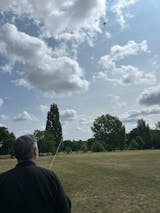
Kite flying has always captured our imagination, weaving through centuries and cultures with its colourful tails and soaring heights. From ancient China, where kites were first flown over 2,000 years ago, to modern-day festivals that draw enthusiasts from around the globe, the humble kite has a rich and varied history.
As we delve into the origins and evolution of kite flying, we'll uncover fascinating stories of innovation, tradition, and even espionage. Whether used for military purposes, scientific experiments, or simple leisure, kites have played a surprising role in shaping our world. Join us as we explore the captivating journey of kite flying through time.
Key Takeaways
- Ancient Origins: Kite flying originated over 2,000 years ago in ancient China, where it served ceremonial, military, and signalling purposes.
- Cultural Expansion: The practice spread across Asia and Europe, influencing various cultures, ranging from Japanese and Korean festivals to European scientific explorations.
- Scientific Contributions: Kites played a pivotal role in scientific advancements, including Benjamin Franklin's electricity experiments, meteorological measurements, and early aviation studies.
- Cultural Significance: Kite flying has substantial cultural importance, symbolising concepts like peace, good fortune, and freedom in diverse societies worldwide.
- Modern Innovations: Advances in materials and technology have led to sophisticated kite designs for recreational, competitive, and professional uses, including sports like kite surfing. Kites made from Ripstop Nylon have become very popular in recent years.
Origins of Kite Flying
Early Beginnings in China
Kite flying dates back over 2,000 years, originating in ancient China. Historical texts suggest that Chinese philosophers like Mozi and Lu Ban designed early kites. Initially made from wood and silk, these early kites had religious and ceremonial roles. Bamboo frames provided strength, while silk fabric allowed them to soar high. These early Chinese kites were sometimes used for military purposes, such as signalling troops and measuring distances. For instance, General Han Xin supposedly used kites to calculate the length of tunnels needed during the Han dynasty.
Expansion Across Asia
Kite flying quickly expanded beyond China to other parts of Asia. In Japan, kites became popular during the Edo period (1603-1868), where kites, traditionally made from bamboo and paper, held symbolic significance in festivals. Boys' Day festivities prominently featured kites, illustrating their cultural importance. In Korea, kite flying took off during the Goryeo dynasty (918-1392) and was used for both entertainment and military communication.
Even in India, kites became integral to various cultural celebrations like Makar Sankranti. These kites, often made with simple materials such as paper and bamboo, became a part of both popular culture and local traditions. The spread of kite flying across Asia shows how this unique practice adapted to and influenced different societies and their customs.
Kite Flying in Medieval and Renaissance Europe
Introduction to the West
Kite flying reached Europe during the medieval era through trade routes connecting Asia and Europe. By the 13th century, travellers like Marco Polo introduced kites to the Western world. These early kites in Europe often drew inspiration from Chinese designs, featuring simple yet effective structures made from paper or silk mounted on wooden or bamboo frames.
Kite flying gained popularity in various European countries for entertainment and scientific exploration. During the Renaissance, innovations in science and art spurred further interest in kites. Prominent figures such as Leonardo da Vinci sketched kite designs, showing their potential in aeronautical studies. These early European kites also served as educational tools for children, encouraging experimentation and curiosity.
Variations and Innovations
As kite flying took hold in Europe, diverse modifications emerged to adapt the kites to local preferences and materials. By the 16th century, European kite makers began experimenting with different shapes and sizes. Hexagonal and diamond-shaped kites became common, made with durable materials like parchment and linen.
One significant innovation was the addition of tails to increase stability. By attaching long strips of cloth or string to the kite, enthusiasts ensured smoother flights. These design changes not only made kites more user-friendly but also opened up the activity to children. Delta kites for kids became increasingly popular, serving as both toys and learning tools.
In the scientific community, Benjamin Franklin's famous 1752 experiment with a kite and key demonstrated kites' ability to conduct electricity. Though not Medieval or Renaissance, this milestone builds on European kite innovations and highlights their role in scientific discovery.
The Role of Kites in Scientific Advancements
Benjamin Franklin and the Kite Experiment
In 1752 Benjamin Franklin conducted a groundbreaking experiment using a kite during a thunderstorm. By attaching a key to the kite, he demonstrated that lightning is a form of electricity. This experiment marked a pivotal moment in electrical science and further proved the practical scientific value of kite flying. Franklin's use of a kite, a tool typically seen as a toy for children, showcased its potential beyond mere entertainment.
Meteorology and Aeronautics
Kites have played a significant role in the advancement of meteorology. In the late 19th century, meteorologists used kites to carry instruments into the atmosphere to measure temperature, humidity, and atmospheric pressure. This data collection improved weather forecasting. Kites allowed scientists to explore upper air conditions, providing critical insights into meteorological phenomena.
Kites have also contributed to the field of aeronautics. Early aviation pioneers, including the Wright brothers, experimented with kites to understand the principles of flight. By studying the aerodynamic properties of kites, they gathered essential knowledge that eventually led to the development of the aeroplane. Scientific exploration with kites has persisted, influencing modern aeronautical engineering.
| Year | Person/Group | Contribution |
|---|---|---|
| 1752 | Benjamin Franklin | Electrical science |
| Late 19th Century | Meteorologists | Weather forecasting |
| Early 20th Century | Wright Brothers | Aeronautics |
The use of kites in scientific advancements highlights their versatility. From Franklin's experiment with electricity to their applications in meteorology and aeronautics, kites have consistently proven valuable in scientific research.
Kite Flying as a Cultural Phenomenon
Festivals and Competitions Worldwide
Kite flying has become a significant cultural event worldwide. In India, the International Kite Festival held in Gujarat attracts participants from over 40 countries. Known as Uttarayan, this festival marks the end of winter and is celebrated with vibrant, colourful kites filling the sky. In Japan, the Hamamatsu Kite Festival celebrates the birth of a child by flying large, traditional kites called "tako."
Brazil hosts the Festival Internacional de Pipas e Papagaios in Rio de Janeiro, where kite-flying enthusiasts display their skills. The Bali Kite Festival in Indonesia is noted for its massive kites and traditional gamelan music. In the United States, the Washington State International Kite Festival is a week-long event featuring demonstrations and competitions. These festivals showcase the global appeal of kite flying for both adults and kids.
Symbolism and Cultural Significance
Kite flying holds deep cultural significance in many societies. In China, kites have been around for over 2,000 years and are believed to ward off evil spirits. They are seen as symbols of peace and good fortune. During the Ching Ming Festival, people fly kites to honour their ancestors.
In Afghanistan, flying kites is a national pastime, symbolising freedom and resilience. "Gudiparan bazi" (kite flying) is a traditional activity that connects generations. In Thailand, the Chula-Kite and Pakpao-Kite represent the battle between male and female kites, embodying the balance of power.
For many, kites offer not just entertainment but act as powerful cultural symbols. They bridge traditions and modern festivities, highlighting their enduring relevance.
Modern Innovations in Kite Design
Materials and Technology
Advancements in materials and technology have revolutionised modern kite design. While traditional kites used materials like paper, bamboo, and silk, modern kites incorporate synthetic fibres and durable plastics. Ripstop nylon, carbon fibre rods, and polyester composite materials exhibit enhanced durability and lightweight properties, making kites more resilient against environmental stresses. These high-tech materials have enabled the development of intricate and high-performance kites for both recreational and professional use.
Computer-aided design (CAD) software allows for precise modelling and simulation of kite behaviour under different wind conditions. Manufacturers use this technology to optimise the aerodynamics of kites, resulting in superior flight stability and control. Innovations like adjustable bridle systems and dynamic tension mechanisms further enhance performance, catering to a wide range of kite flying experiences, from casual kites for children to advanced stunt kites.
Kite Surfing and Sports
Kite surfing, a popular water sport, highlights modern kite innovation in the sporting arena. This adrenaline-pumping sport involves using large, specialised kites to propel riders across water surfaces. Kite surfing kites, with advanced aerodynamic profiles, are designed for maximum lift and precise control. Inflatable kite structures and de-powering systems contribute to enhanced safety and ease of use during high-speed manoeuvres.
Kiteboarding competitions attract enthusiasts worldwide, showcasing the versatility and performance of modern kites. Besides kite surfing, other kite-related sports include kite landboarding and snowkiting, which utilise similar kite technology adapted for different terrains. Modern innovations have broadened the scope of kite-related activities, making them accessible and appealing to a wider audience.
By incorporating cutting-edge materials and technology, modern kites have evolved significantly from their traditional counterparts. Today’s kites, ranging from kids kites to professional sporting kites, reflect the remarkable advancements in design and performance.
Conclusion
Kite flying has evolved remarkably from its ancient origins to its modern-day innovations. The journey from traditional materials to advanced technologies has not only enhanced performance but also broadened the appeal of kite-related activities. Today kites continue to be a symbol of cultural heritage and a source of joy for people of all ages around the world. As we embrace these advancements we also honour the rich history that has shaped the vibrant world of kite flying.
Frequently Asked Questions
Where did kite flying originate?
Kite flying originated in China around 2,000 years ago. The earliest kites were made from simple materials like silk and bamboo.
What significance do kites hold in various cultures?
In many cultures, kites symbolise freedom, peace, and a connection to the spiritual realm. For example, in Japan, kites are flown during festivals to bring good luck and ward off evil spirits.
How have materials used in kite making evolved?
Traditional kites were made from natural materials like silk, paper, and bamboo. Today, modern kites use synthetic fibres and plastics for improved durability and performance.
What role does computer-aided design play in modern kite making?
Computer-aided design allows for precise modelling and optimisation of kite shapes and structures, leading to more efficient and high-performing kites.
How has the advent of modern materials impacted kite performance?
Modern materials such as synthetic fibres and high-strength plastics have drastically enhanced kite performance, making them lighter, more durable, and capable of performing complex maneuvers.
What are some contemporary uses of kites?
Today, kites are used in various recreational and professional activities, including kite surfing, kiteboarding, and aerial photography.
How has the evolution of kites made the activity more accessible?
Advancements in design and materials have made kites easier to assemble, more resilient, and adaptable to different conditions, thus broadening their appeal to a wider audience.






